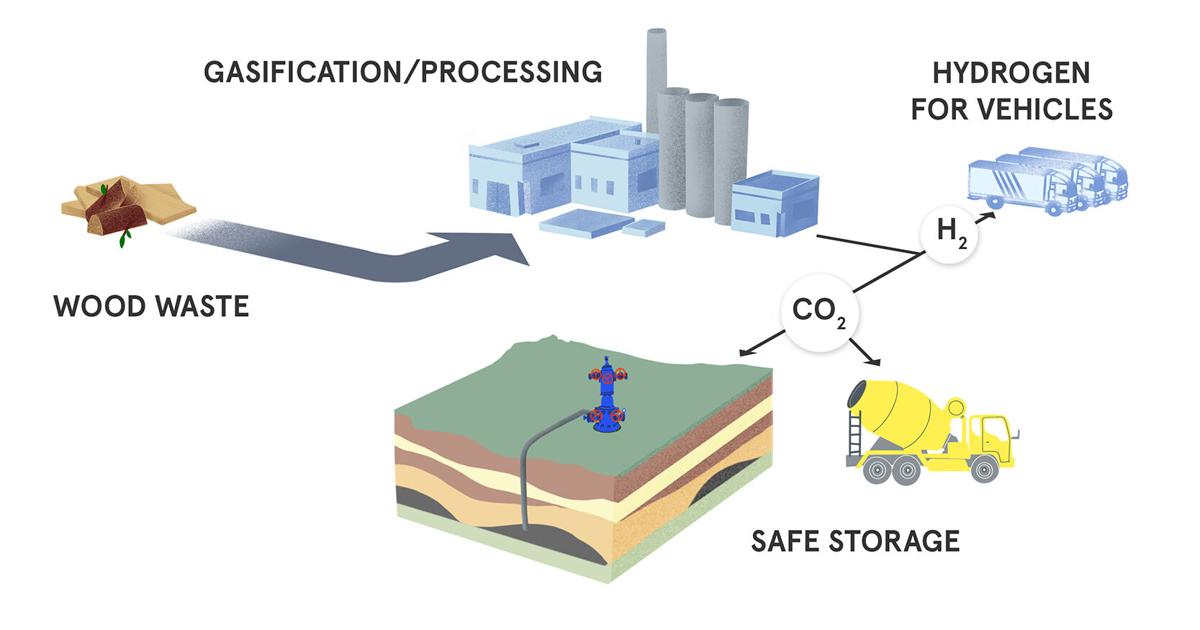
Kern's carbon management rush has a new entrant with a Southern California company's proposal to gasify local ag waste for production of hydrogen and carbon dioxide that can be injected underground or, in a novel twist, stored in concrete.
The startup, Mote, announced Wednesday engineering work has begun on a $100 million facility proposed outside Bakersfield that would capture 150,000 metric tons of carbon dioxide per year — roughly equivalent to taking 33,000 cars off the road — and 7 million kilograms of hydrogen for transportation starting as soon as 2024.
Combining existing technologies with local access to biomass waste and ideal geological formations, the proposal is the latest carbon burial project seeking federal tax credits and different state financial incentives for fighting climate change.
"Carbon removal and clean hydrogen are booming markets right now," Managing Partner Andy Bonsall at London-based climate action investor Counteract, a Mote shareholder, said in Wednesday's news release. "Mote is extraordinarily positioned to scale quickly for huge impact."
Other active proposals by much larger companies aim to accomplish similar goals in Kern but on a larger scale and higher cost, sucking air out of the atmosphere directly or removing it from the emissions stream of a power plant in western Kern. At least one other project unveiled recently would gasify biomass and bury CO2 with no mention of concrete sequestration.
Mote has not applied for the environmental, injection, air and water permits it would require before beginning operation. But the company said it has a prospective partner developing the CO2 storage site, whose location it declined to disclose.
The county's top planner and energy-permitting specialist, Lorelei Oviatt, said she has seen more of this sort of thing lately as companies announce agreements and investments without taking initial steps toward the conditional use permits and environmental reviews they would need.
"All the companies are doing this," she said. "It's fine. But no, I've never talked with these particular people."
The county has received a single application for carbon capture and sequestration, from California Resources Corp. The Santa Clarita-based oil producer has disclosed plans for solar- and natural-gas-fueled plants that would either take carbon directly out of the air or remove it from the exhaust of a power plant it operates in Elk Hills.
Oviatt has also heard CO2 injection proposals from Bakersfield-based Aera Energy LLC, San Ramon-based Chevron Corp. and Bakersfield-based Jaco Oil Co. Others hoping to inject carbon underground in unincorporated Kern "need to come talk to me," she said.
Mote finished top in its class at the Rice University Clean Energy Accelerator. This fall, it announced receiving investor seed money.
The company said it will combine commercial technologies with new efficiency that can be replicated at a scale that lowers the cost of fighting climate change.
Trimmings and wood from Central Valley orchards and vineyards have posed problems in California for years. Almond growers and vineyards in particular generate large amounts of wood that if left to decompose produces the potent greenhouse gas methane.
Many power plants that used to burn biomass to generate electricity and steam closed several years ago in the face of competition from solar and wind farms.
Open burning has since increased but its imminent prohibition is expected to result in more whole-orchard recycling in which biomass is shredded and incorporated back into the soil where it originated. Some environmental groups prefer that option to the emissions that come with gathering and transporting biomass — plus, it's another form of carbon sequestration.
Besides federal tax credits, Mote expects to receive recurring revenue from California's Low Carbon Fuel Standard. It also hopes to win grant money from the California Energy Commission's financial support for production of renewable hydrogen.
Mote is in talks with Canadian-based CarbonCure Technologies on potentially storing carbon dioxide in concrete at construction sites.
The company said by email all the energy it would need for carbon storage would come from biomass, but that if it needs to liquify hydrogen it may need to bring in external electricity.
Mote said it expects to put out minimal emissions. Its largest source would be related to wood handling.
-
Positive Cases Among Kern Residents: 161,083
-
Deaths: 1,897
-
Recovered and Presumed Recovered Residents: 154,547
-
Percentage of all cases that are unvaccinated: 90.81
-
Percentage of all hospitalizations that are unvaccinated: 91.93
Updated: 12/17/21
"seal" - Google News
December 19, 2021 at 09:45AM
https://ift.tt/3F6QJyu
Biomass plant near Bakersfield would bury or seal carbon in concrete - The Bakersfield Californian
"seal" - Google News
https://ift.tt/3c1qdrW
https://ift.tt/2SzWv5y

No comments:
Post a Comment